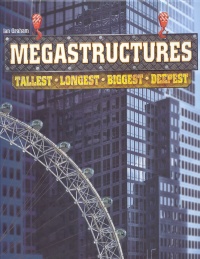| ________________
CM . . .
. Volume XIX Number 10. . . .November 9, 2012
excerpt:
Megastructures, a book of superlatives – tallest, longest, biggest, deepest – will grab the attention of young readers and adults alike. It presents a close-up look at the most amazing structures in the world and examines the science behind their designs, the challenges faced in their construction (including some failures and accidents), and how they are used. In each of four sections (Towering Giants, Gigantic Lengths, Massive Monsters, Darkest Depths), one spread looks at the latest proposals for new projects. Terms in bold are explained in a Glossary. In "Take it Further", readers are urged to put independent thinking to work with a series of questions inspired by the topics in the book. Useful Websites will extend learning. An Index will guide readers to their favourite topic. The large sized (26 cm by 29 cm) book is very well designed with huge eye-popping images of the structures front and centre. Nicely separated chunks of text are strategically placed to describe the features that make these buildings, bridges, machines and tunnels awe-inspiring. Sidebars include 'Mega Facts' with statistics such as, "The Lake Pontchartrain Causeway is so long that it spans one-thousandth of the Earth's circumference." Other sidebars add historical detail, offer comparison in charts or explain concepts such as how a building's shape influences wind deflection around it. Each of the four sections has a foldout page to allow appreciation of one special example of a mega-structure. The first is the Burj Khalifa, Dubai's stunning skyscraper. Readers have to turn the book sideways to see its full height, top to bottom over the four-page spread. Next is the Oresund Link, a bridge/tunnel combo between Sweden and Denmark. Third, London's Olympic Stadium is shown in construction process with its series of layers and rings. Finally, the Channel Tunnel that links the UK and France is illustrated. These foldouts are exciting and effectively bring the size of the projects to life. However, there's a puzzling flaw in the illustrations of two of them. A shadowy Burj Khalifa image hovers in the background of the Oresund Link and London's Olympic Stadium pages. Its presence is not explained: one assumes it is there as a comparison to the length of the Oresund Link, but that feature has no bearing on the Stadium, and, in fact, the image obscures the text in a couple of spots. A printing error, perhaps? Megastructures is a book you can read right through (hard to put down once your sense of 'humongous' is aroused) or one that is fun to browse. There is no Introduction, but the Table of Contents offers tempting headings: Famous Giants, The Hazard Factor, Deep Challenges. One unfortunate omission is any map to show the location of these structures; a chart on each title page lists the Top 10…., with location and height. For such a highly visual book, though, a map would have helped readers place the projects in the world context. Highly Recommended. Gillian Richardson is a freelance writer living in BC.
To comment
on this title or this review, send mail to cm@umanitoba.ca.
Copyright © the Manitoba Library Association. Reproduction for personal
use is permitted only if this copyright notice is maintained. Any
other reproduction is prohibited without permission.
NEXT REVIEW |
TABLE OF CONTENTS FOR THIS ISSUE
- November 9, 2012.
AUTHORS |
TITLES |
MEDIA REVIEWS |
PROFILES |
BACK ISSUES |
SEARCH |
CMARCHIVE |
HOME |
